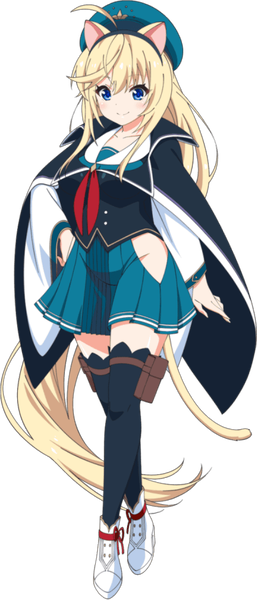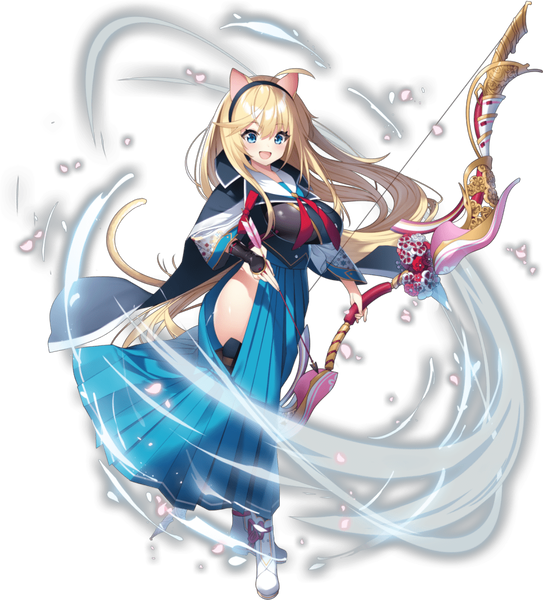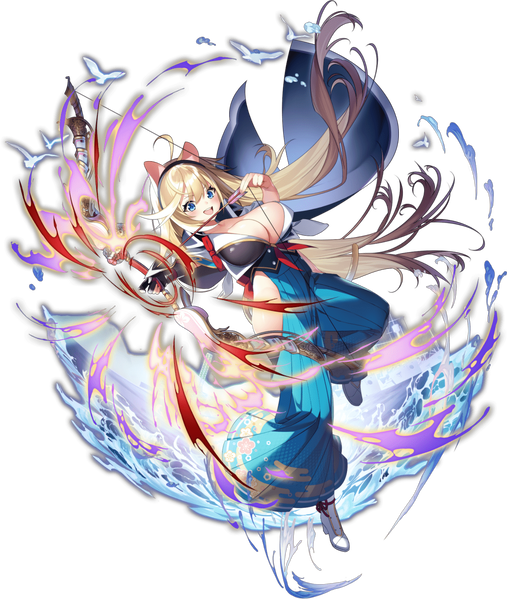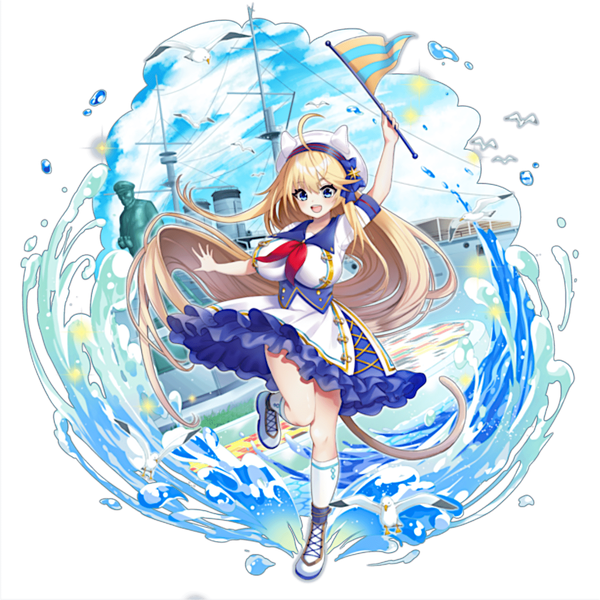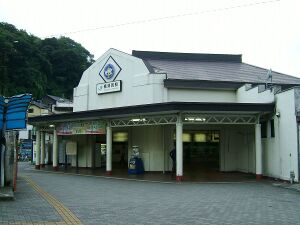Yokosuka
| Yokosuka | |||||
|---|---|---|---|---|---|
| Japanese Name | ヨコスカ | ||||
| Weapon | |||||
| Race | Human | ||||
| Nationality | |||||
| Birthday | June 16 | ||||
| Constellation | Gemini | ||||
| Talents | Well versed in old Nishiki literature and history | ||||
| Likes | Everything about Nishiki, Her shisho, Kyudo | ||||
| Dislikes | Anyone touching her fake ears and tail without permission | ||||
| Strengths | Highly sociable | ||||
| Weaknesses | Inability to read situations calmly | ||||
| Hobbies | Collecting shuin | ||||
Watashi's name is Yokosuka! Watashi's division is from the M. Nishiki's Railroad Army masu! Watashi's specialty is shooting things from afar desu ga, but recently watashi is into shooting out fluttering fans with the bow masu yo. It will be demonstrated at the next Omatsuri, so please come and watch ne!
Layers
| Icon | Title | Release Date | Where to Obtain |
|---|---|---|---|
| [Blonde Great Archer] Yokosuka | 2021 December 24 | [Altar of Judgement - Fire Bird] Event Reward | |
| [Refine Shishou's Bow] Yokosuka | 2021 November 30 | [Magical School Trip in the Town of Ash] Pick Up Gacha, Premium Gacha | |
| [Bow With Soul] Yokosuka | 2021 December 24 | [Nishiki Talk With Sake 'ska] Limited Gacha | |
| [Love's Sailor Cupid] Yokosuka | 2023 May 15 | [Love Me More Papa Perfume] Pick Up Gacha, Premium Gacha |
Obtained Skills
Trivia
- Yokosuka's birthday is the opening date of Yokosuka Station in 1889.
- Yokosuka is was a foreigner with M. Nishikese citizenship, this is a homage to Commodore Matthew Calbraith Perry, who landed his ships in Yokosuka and played a leading role in the opening of Japan to the West with the Convention of Kanagawa in 1854.
- The United States Fleet Activities Yokosuka is a US Military Base that is also a venue near Yokosuka Station, referencing her St. Iris (western) heritage.
- Yokosuka is a Japanophile (親日 "shinnichi" in Japanese) - non-Japanese people who are obsessed with Japanese popular culture. The term "wapanese" (from "white Japanese", or possibly also "wannabe Japanese") first emerged in 2002 as a derogatory term for a non-Japanese, particularly white, person who is obsessed with Japanese culture, particularly anime and manga. This later became "weeaboo" or "weeb", used ironically by non-native fans of Japanese pop culture.
- Yokosuka's liking for archery and the flower motifs on her bow likely references the archery range in Kurihama Flower Park within Yokosuka city.
- A shuin (朱印) is a seal stamp given to worshippers and visitors to Shinto shrines and Buddhist temples in Japan. The seal stamps are often collected in books called shuinchō (朱印帳) that are sold at shrines and temples. The stamps are made exclusively by Buddhist Hōshi or Shinto Kannushi.
- The statue in the background of [Love's Sailor Cupid] is the statue of Heihachiro Togo, the admiral of the Japanese fleet at the Battle of the Sea of Japan, one of the naval battles of the Russo-Japanese War. The battleship in the background is the IJN Mikasa. After 1922, Mikasa was decommissioned in accordance with the Washington Naval Treaty and preserved as a museum ship at Yokosuka.
- [Love Sailor's Cupid] Special Skill is a direct reference to Kongo's attack from Kantai Collection, the most popular game of all time in DMM's history.
Counterpart
Yokosuka Station (横須賀駅) is a passenger railway station in located in the city of Yokosuka, Kanagawa, Japan, operated by East Japan Railway Company (JR East). The station consists of a bay platform and a side platform serving three tracks. Platform 1, formerly used for freight operations, is currently not in use. Platform 2 is used for trains which originate or terminate at Yokosuka, and Platform 3 is for bi-directional traffic. The station has a Midori no Madoguchi staffed ticket office.
Yokosuka Station opened on June 16, 1889 as the initial terminal station on the Japanese Government Railways (JGR) spur line from Ōfuna to serve the Yokosuka Naval Arsenal and related Imperial Japanese Navy facilities at Yokosuka. This spur line was renamed the Yokosuka Line on October 12, 1909. After World War II, the station continued to serve as a base for transporting goods to the U.S. Navy Yokosuka base for some time. The present station building, the third building on this site was completed in April, 1940 and the line extended past Yokosuka to Kurihama Station in 1944. Freight operations were discontinued from February 1, 1984. The station came under the management of JR East upon the privatization of the Japanese National Railways (JNR) on April 1, 1987.
Yokosuka station consists of bay platforms and a side platform serving three tracks. Track 1, formerly used for freight operations, is currently not in use due to the development of motorization and other factors, and the facilities for freight transport have been removed. Track 2 is used for trains which originate or terminate at Yokosuka, and Track 3 is for bi-directional traffic. Most of the freight station area was used as the Well City Yokosuka, where public facilities of Yokosuka City and the skyscraper residential complex "Tenku no Machi" were built, but some side lines still remain on the mountain side and the sea side. Although not in use at all times, the sidetrack immediately adjacent to Track 3 is often used to hold temporary trains and business motor cars coming from the Tokyo area.
Until the October 16, 2004 timetable revision, the Shonan Shinjuku Line (which operates from this station to Shinjuku) used to use the 215 Series trains that depart from this station (turnaround). The trains used were Series 215 trains. Since March 15, 2014, some Narita Express trains (Series E259 trains) departing from and arriving at Yokohama and Ofuna Stations have extended their service to Yokosuka Station as extra trains only on weekends and holidays during peak season, but the service was suspended in January 2017.Wikipedia
Mikasa (三笠) is a pre-dreadnought battleship built for the Imperial Japanese Navy (IJN) in the late 1890s, and is the only ship of her class. Nnamed after Mount Mikasa, Mikasa was laid down by Vickers at their Barrow-in-Furness shipyard on 24 January 1899. Baroness (later Countess) Hayashi, the wife of the then resident minister to Great Britain (later Ambassador), served as Mikasa's sponsor, launching the hull on a rainy, but otherwise perfect ceremony on 8 November 1900. She would be completed on 1 March 1902, and after a visit to Devonport, she left Plymouth on 13 March, bound for Yokohama, under the command of Captain Hayasaki.
Six days after the Treaty of Portsmouth that ended the war was signed, Mikasa sank at her moorings after a fire and magazine explosion at Sasebo on the night of 11/12 September 1905 that killed 251 crewmen. She was refloated on 7 August 1906, reconstructed and repaired at Sasebo Naval Arsenal. The navy took the opportunity to upgrade her existing armament with more powerful 45-calibre twelve-inch and six-inch guns during the two years it took to repair the ship. Mikasa was restored to active service on 24 August 1908. In 1912, Mikasa came extremely close to suffering another main magazine detonation, when a suicidal sailor attempted to blow her up at anchor near Kobe. During World War I, she served on coast-defence duties, based at Maizuru, during 1914–15 and was then assigned to the Second and Fifth Squadrons, in that order, for the rest of the war. The ship supported the Japanese intervention in Siberia during the Russian Civil War during 1921 and was reclassified on 1 September 1921 as a first-class coast-defence ship. On 17 September, Mikasa ran aground near Askold Island off Vladivostok, but was not seriously damaged
The ship was decommissioned on 23 September 1923 following the Washington Naval Treaty of 1922 and scheduled for destruction. However, at the request of the Japanese government, each of the signatory countries to the treaty agreed that Mikasa could be preserved as a memorial ship with her hull encased in concrete. On 12 November 1926, Mikasa was opened for display in Yokosuka in the presence of Crown Prince Hirohito and Tōgō. Following the surrender of Japan in 1945, the ship deteriorated under control of the occupation forces. In 1955, American businessman John Rubin, formerly of Barrow, England, wrote a letter to the Japan Times about the state of the ship, which was the catalyst for a new restoration campaign. With the support of the Japanese public, and also Fleet Admiral Chester W. Nimitz, the restored battleship reopened in 1961. On 5 August 2009, Mikasa was repainted by sailors from USS Nimitz. Mikasa is the only surviving example of a pre-dreadnought battleship in the world. Mikasa is remembered in Barrow-in-Furness, the town of its construction, by Mikasa Street on Walney Island. Wikipedia
Map
Gallery
- Pages using Tabber parser tag
- Pages using DynamicPageList3 parser tag
- Weapon Bow
- Human
- Nishiki
- Gemini
- Element Pierce
- Element Fire
- Element Water
- Metro Train Knights
- Japan

